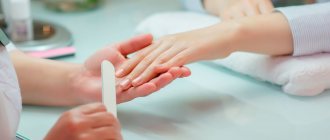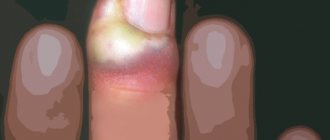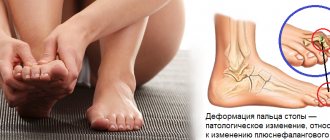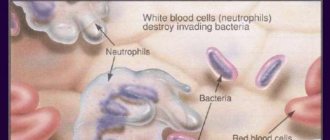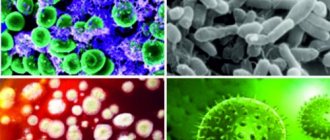- What is nail hyperkeratosis?
- Causes
- Treatment methods for hyperkeratosis of the nail plate
Hyperkeratosis of the nail bed is an excessive thickening of the stratum corneum against the background of slow desquamation of dead cells. As a result, the nail takes on a spherical shape, its color becomes yellow and uneven, and the nail plate becomes brittle and inelastic. The disease occurs in a chronic form. The pathological focus can spread to neighboring structures - affecting other nails and skin of the foot. Against the background of mycoses, itching and an unpleasant odor are possible.
Causes of pathology
- Frequent nail injuries.
- Wearing tight shoes.
- Diabetes mellitus and other endocrine pathologies.
- Hereditary dysfunctions.
- Psoriasis, lichen planus, ichthyosis, keratoderma, papillomatosis, chronic eczema.
- Imbalance of vitamins and microelements.
- Insufficient hygiene.
- Imbalance of the intestinal genome, including after treatment with antibiotics.
- Unbalanced diet.
- Sleep disturbances.
- Severe stress.
- Allergy to cosmetics.
As a rule, the disease develops against the background of a fungal infection of the nail, often against the background of immunodeficiency.
Useful tips from the doctor
Prevention of nail fungus or how to avoid getting a fungal infection
- Have individual accessories: shoes, slippers, washcloth, pumice stone, foot towel and manicure set.
- After use, wash the bathtub and shower cabin with powder (chlorine) and a cloth.
- Nail scissors are disinfected by immersing them in alcohol and then burning them over a burner flame.
- After contact with surfaces and objects potentially contaminated with fungus (beaches, baths, swimming pools, gyms, other people's shoes, sports equipment, etc.), it is recommended to treat your feet with a spray (for example, MIKOSTOP).
Treatment methods for hyperkeratosis of the nail plate
Hyperkeratosis is treated by a highly specialized specialist – a podiatrist. Therapy combines systemic and local methods and is prescribed after a comprehensive diagnosis. This approach allows you to accurately influence the cause of the pathology, reduce treatment time, and avoid complications and relapses. Since in most cases, subungual hyperkeratosis develops against the background of nail fungus, the patient is prescribed antifungal drugs - tablets, varnishes and ointments.
Local antifungal treatment and medical pedicure
Local treatment is aimed at suppressing fungal microflora and reducing keratinization. To do this, the clinic performs a medical pedicure - the surface layers of the thickened nail are removed with a cutter.
Baths
It is recommended to take warm salt foot baths every day - dissolve 100 grams of sea salt in 10 liters of water. After the procedure, the steamed tissues of the surface of the nail and the skin around it are removed with pumice and buffs. Then the local drug prescribed by the doctor is applied.
Removing the nail plate
In advanced cases, in order to ensure the delivery of drugs to the affected tissues, complete removal of the nail plate is indicated using mechanical cutters, special compounds and patches.
Diet
To get rid of the fungus, it is recommended to adjust your diet. Sweets and yeast baked goods are excluded from the menu. The diet is balanced in proteins, fats, carbohydrates, vitamins and microelements under the supervision of a nutritionist.
Immunotherapy
If immunodeficiency is detected during diagnosis, the immunologist prescribes immunomodulatory therapy.
Hygiene
Fungal infections actively multiply in a warm, humid environment, so the inner surface of shoes is treated daily with a pharmaceutical disinfectant solution, and socks, tights and stockings are washed daily. Shoes are changed if necessary - they should not stimulate foot sweating. Scissors and nail files must be strictly individual and treated with a disinfectant solution after use. You will also have to temporarily avoid going to saunas and swimming pools to prevent contact infection.
Traditional methods
Fungi are not sensitive or slightly sensitive to nonspecific agents, therefore traditional methods of treating nail hyperkeratosis are ineffective. Under their influence, the fungal flora develops immunity and infects new structures. The disease becomes severe. Podologists strongly recommend that if you suspect nail hyperkeratosis, you should immediately contact a specialist.
It is impossible to restore a nail plate affected by hyperkeratosis; you can cure the disease and wait until a healthy nail grows. The course of therapy is from 2 to 6 months. After 2 weeks and 2 months after complete elimination of symptoms, control tests are taken to determine the presence/absence of fungus.
How to treat onychauxis?
To correct the condition of the nails and return them to normal thickness, careful care and elimination of the factor that caused the changes are necessary.
If the cause is diabetes, you need to be more careful in keeping your glucose levels within normal limits. This is done by following the recommendations of the endocrinologist, taking glucose-lowering drugs or insulin injections, depending on the type of disease.
To treat edema and hypoxia in the tissues of the lower extremities caused by impaired venous and lymphatic outflow, medications are prescribed to strengthen the walls of blood vessels, thin the blood, and compression stockings.
For atherosclerosis, medications and diet are prescribed to reduce blood cholesterol levels.
If the cause is a vitamin deficiency, nutritional correction or taking vitamin-mineral complexes is necessary.
If there is inflammation or infection, antiseptic treatment is carried out and medicinal ointments are prescribed.
To improve blood circulation in the extremities, special gymnastics for the feet helps.
To treat onychauxis with folk remedies, you can find many tips on the Internet for softening nails. These are warm baths with apple cider vinegar, hydrogen peroxide, soda, and herbal infusions. Before using this treatment, consult your doctor, as some diseases, including circulatory problems, these procedures are contraindicated.
The main thing is to eliminate the cause of the violations, then in the future the nail will grow correctly. In case of injury, it will take time for the nail plate to recover. A medical manicure or pedicure will help keep your nails healthy and control their growth during this period.
Symptoms of thickening on the legs
Many people live for years with increased thickness of toenails and do not even suspect that this is a violation of the norm. Healthy toenails should not be much thicker than those on your hand. The functional size of the stratum corneum of the plate rarely exceeds 2 mm , and the minimum thickness starts from 0.5 mm . When trimmed, the toenail plate cannot require more effort or any particularly strong tool. The nail itself should be clear, slightly pink, but not completely dull white or yellow.
Thickening of the nail is often accompanied by a change in color
Thickening of the stratum corneum for any reason often causes a change in color - darkening or yellowing of the nail, and only later does an increase in the size of the plate occur. The transformation can take different forms: nails grow only laterally or suddenly gain vertical thickness, as with onychogryphosis.
A uniform increase in the stratum corneum over the entire surface can be small, 3-4 mm, or have an impressive size - 1 cm or more. Thickening of the nail in older people should not be attributed to age-related changes - it may be a disease not related to the years lived.
Regular self-diagnosis is good for health, but the final verdict must be made by a physician. Fungal diseases of the nails are dealt with by a mycologist, but in other cases there is no need to consult a dermatologist.
There are dozens of diseases that can cause thickening of the nail plates. Some of them are infectious, others are somatic, and some are congenital. Some diseases can be cured or stopped, but there are a number of causes of thick nails that cannot be permanently changed.
Bath recipes
Now let's move on to the bath recipes. Perhaps one of these would be suitable:
- Squeeze two tablespoons of lemon juice into 5 liters of water and mix everything. Please note that lemon juice causes a burning sensation, so this bath can only be used in cases of diseases in which the skin on the foot and around the toes is not damaged.
- If problems with nails are a consequence of injury, then dilute celandine juice in water: you will need a tablespoon of juice for two liters of water. This product is very effective. But after it, the nails may turn orange-yellow for a short time. Don't worry, the normal color will return soon. It is also prohibited to use in cases of nail fungus. The fact is that the juice will penetrate deep into the affected nail and this will probably result in internal burns.
- If you need not only a nail softener, but also a disinfectant, then a bath with soap, not regular soap, but tar soap, is suitable. It is recommended to be used specifically for infectious lesions of the nail plate. You can find this soap in any pharmacy. It needs to be grated (always a coarse one). You will need about a quarter of the bar, which should be diluted in a small amount of water. For greater effect, you can even lubricate your nails with this solution before putting them in the water. Immediately after lubricating, wrap your nails for 10 minutes, and then proceed to the bath. During the procedure, do not forget to add hot water so as not to catch a cold.
Paronychia
Paronychia
is a skin condition that causes redness and swelling around the nail. Over time, nails may become thick. A person may notice that their nails begin to peel. Paronychia most often develops in people who suck their fingers, when washing dishes, or when their nails are severely trimmed.
A number of occupations increase the risk of thickening nails:
- dishwasher;
- bartenders;
- laundry workers;
- cleaners;
- cooks;
- medical staff;
- fishermen.
Diagnosis and treatment of thickened nails
Before starting treatment, you need to identify the exact cause, and not guess it, self-medicating and wasting time.
To do this, you need to contact a dermatologist and get a referral from him for the appropriate tests. After passing all the tests, when the reason becomes known. You may have to change your doctor. A thick nail, or rather a small piece of it, is taken for analysis. Thickening of the nails, which appears due to fungus, lymphostasis, and lack of essential vitamins, can be treated with folk remedies. But if the thickening occurs due to liver disease, diabetes, cardiovascular diseases, diseases of the nervous system, it is better to treat them using the methods prescribed by the doctor.
Treatment of nails of an elderly person. Pedicure at home
Trimming thick nails is not an easy task. Therefore, before this procedure, the nails should be softened. Daily baths are suitable for steaming your feet and softening your toenails. The easiest way is to soak your feet in a bowl of hot water for 15-20 minutes. During the procedure, boiling water can be added as the water in the basin cools.
Infusions of medicinal herbs will help soften and at the same time disinfect the skin and toenails. To do this, brew 5-6 tablespoons of dry herb in two liters of boiling water and let it brew for an hour. Then strain the infusion and heat it up, keep your feet in the solution for about 20 minutes. The following types of herbs are suitable:
- Chamomile – gets rid of germs, relieves inflammation, has healing properties;
- The series – fights inflammation and skin irritation, relieves itching;
- Sage – heals small wounds and its aroma helps relieve tired legs.
In addition to herbal infusion, your feet can be steamed in a soda solution. Soda has softening, antiseptic, antifungal, anti-inflammatory properties. Dilute soda in the ratio of 1 liter of water to 2 tablespoons of soda. Keep your feet in the solution for about 30 minutes.
After the steaming procedure, dry your feet and begin treating your nails. For older people, nail clippers, rather than nail scissors, are best suited. Carefully trim your nails and treat your toes with an emollient cream. You can use a special foot product, a cream that contains urea, panthenol, or a regular nourishing cream.
Post-traumatic therapy
For a thickened nail, the cause of which is associated with a leg injury, it is important to reduce the load. If the injured area does not allow you to walk normally, it is better not to leave the house for several days. Otherwise, you need to apply a patch to the damaged nail and wear open-toed shoes. Recinol can be used to treat infected areas.
Recinol
The active component of the product has anti-inflammatory and anesthetic effects. Recinol restores tissue structures, which speeds up the healing process. An injured nail can be treated with medication, using ointment or gel. Troxevasin, heparin ointments, and arnica are suitable. Treatment of the nail plate should be performed several times a day for about a week.




